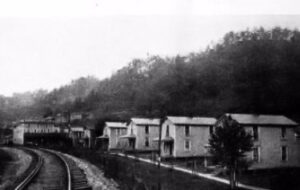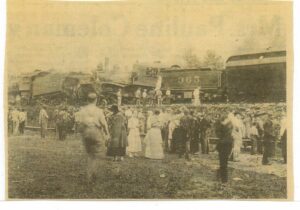It was a normal day in Letcher County Kentucky on Thursday, September 20, 1917. There was no indication of the events that would unfold that evening at 4 pm. The Seco Train Accident on September 20, 1917, was a horrible accident that has never been fully explained.
Louisville and Nashville passenger train Number 1 was making a daily run. Train No. 1 traveled from Lexington, Kentucky, and entered Seco on its way to Neon, Kentucky. The passenger cars were filled with men, women, and children. Everything was in running order with the engine and there were no reported faults.
At the Neon rail yard, a coal engine (which is not numbered in the articles) had a full head of steam. The train had several cars loaded with coal from the different mines. It was getting ready to run along on the designated No. 4 track. Before the accident, it was not a numbered train that was heading to Whitesburg, Kentucky, then onward to make its delivery of coal to the steel mills of Pennsylvania. There were no issues with the engine being in perfect running order and there did not appear to have faults with its braking system at that time.

The Mysterious Hostler
According to some of the newspaper sources of that time, this is what was alleged. A man who was not familiar with the workings of a train, climbed on board the engine with the coal cars. It is not clear if this man did this on purpose willingly or if it was out of curiosity. However, he is said to be a hostler. A train hostler is an engineer that moves trains around in a rail yard to get them in position for their later use.
The man in question, then put the train into gear and jumped from the train once it began to roll. Other articles have the man jumping from the train once it started to gather speed. In yet another article, there is a story of an unidentified prowler that may have been the cause of the accident.
This is what is claimed even though there do not seem to be any arrests or convictions in this matter. Also, the man in question is not named by any of the articles. So, it could be the case that the man did not exist and was used as a scapegoat to explain why the train was moving on its own. There are a couple of articles that state that the reason for the train to start rolling is a mystery. And still, another claim that no one is taking seriously about the story of the mystery man. It is rumored to be a fiction to relieve L & N Railroad of any financial liability according to the source.

Rescue Attempt
The coal train and its cars were running in reverse on the tracks. There are some reports that this train was running at 45 mph on this track on its way to Whitesburg without a driver.
Several of the L & N (Louisville and Nashville) workers saw the train begin its riderless journey down the tracks. Alarm quickly went out in the Neon train yard. The workers knew that the Lexington passenger train was due to arrive on its normal schedule. From Neon the men hastily tried to assemble and catch the runaway train with a rescue engine and rescue party onboard. This attempt was unsuccessful. However, they were the first rescue on the scene and did help as many passengers and injured as possible.
Seating and Car Arrangements
Louisville and Nashville passenger train Number 1 was arranged a certain way because of the time that they lived in and because of soot from the engine. Remember that all trains of that time ran on coal-powered steam engines. Trains arranged their cars according to what or who would get the brunt of the smoke and soot that came from the engine. The first cars were often filled with baggage. In the case of the L & N passenger train No. 1, only one car was filled with baggage. the other cars were filled with passengers.

Collison
Seeing the oncoming backward runaway train approaching them at a high rate of speed, the engineer, “Dad” Gilson aboard the passenger train held back on the throttle for as long as he could. He also yelled to his fireman, John Allphin, to jump. However, either Gilson was not heard, or Allphin did not react fast enough as only Gilson jumped from the train engine. Some of the passengers who saw the oncoming train also jumped from the passenger train to get away from the collision.
When the trains collided, the trains hit each other so hard that it gave a huge thunderous noise that shook the houses and buildings near it. The baggage car telescoped into the first passenger car. John Allphin, the train fireman, and two passengers in the first car died instantly.
Due to the quick actions of Dr. Pigman, Dr. Wright, the rescuers, citizens of the area, and a crew from Millstone, Kentucky, and all who answered the call for help, there was a count of twenty-five passengers who were injured but not fatally. There were many deaths found on the scene or who died within days of the accident and their names will be called out later in this posting.
A later train arrived that evening carrying doctors and surgeons from Hazard and Lexington, Kentucky. By the time this train had arrived at the scene, all the severely injured victims had been removed from the train and were being treated for their injuries at the Fleming Hospital in Fleming, Kentucky.
Location of the Accident
The location of the collision happened in a congested area of Seco. With the train tracks running between the river and the town. Southeast Coal Company Hospital, the old Seco grade school, and the bridge that crossed over to Boone Creek into Seco were located close to where this accident happened. Houses in the area shook and the noise from the two trains colliding into each other scared many of the people who lived in the area.

Injuries from Coach Car Number Two
Two of the occupants in Coach Car number one were killed on impact. The two dead from passenger car number two can be A. Pearson, Profession unknown, who might have died instantly or a few days later. Frank Williams, a Miner, died instantly. Or possibly, Norris Williams, a Railroad brakeman, who may have also died instantly or a few days later.
The rest of the occupants in the car had to be removed from the wreckage. It was a scene of twisted metal with sparks, hot embers from the burning coal. The passenger train engine was smashed with the boiler split open with the remains of the baggage car and the passenger car number one jumbled together. Both engines had been destroyed in the accident.
Many of the passengers that were found in this wreckage had survived the impact, however, they were severely burned and had multiple injuries.
Injuries From the Other Coach Cars
S.T. Walker, the railway mail clerk, sustained multiple and serious injuries to the head and neck. R.C. Kennedy, Lineman for the L & N Railroad, sustained injuries to his body and neck when he was thrown headfirst into the ground. Tilden Wright sustained a broken leg and internal injuries when he was thrown from the coach.
Known Deaths
John Allphin, the train’s locomotive fireman, died instantly
James Hays, Miner, who passed away from his injuries the next day.
J. A. Pearson, Profession unknown. He has two conflicting death statements on his death certificate. One states that he died of a fractured skull and pneumonia on September 22, 1917, from his injuries from the accident. And the other statement reads that he died instantly on the scene.
Frank Williams, a Miner, died instantly
Norris Williams, Railroad brakeman, death certificate implies he died instantly but has his death listed as September 24, 1917.
Aftermath
There was a lawsuit brought by Tilden Wright against the Lexington and Nashville (L&N) railroad company. The suit was for the recovery of injuries and damages from the accident.
Lousiville & Nashville Railroad Company claimed that they were not responsible for the wreck as it was caused by a person or persons unknown and not captured.
The judge agreed with the railroad and thus the lawsuit was unsuccessful. However, Wright did deny that this did happen however, there was no evidence to prove this story right or wrong.
A Very Huge Thank You to the Bates and Wright Families
Here at Kentucky Tennessee Living, we give credit where credit for our stories is due. While there is not a whole lot of information that is published online about this accident. There are some people that have preserved the information for future generations. And to the owners of the Wright-Bates website, we owe a huge debt of gratitude for preserving the articles that are used in this post. Without you, the accident and all of those who died would be lost to history.
We hope that you have enjoyed this walk through the Seco, Kentucky train wreck of 1917. While we understand that there is not very much information out there about the wreck, we found all we could concerning its historical events. If anyone has any updated material concerning this accident, we would be extremely interested in hearing or reading about the topic.
For More Information About the Seco Train Wreck of 1917
The 1917 Seco, Kentucky Train Wreck Wright Bates Website
Articles contained in part or in full on the Wright-Bates Website
- The 1917 Seco, Kentucky Train Wreck. Appalachian Quarterly
- Louisville, Kentucky Courier Journal September 21, 1917
- Lexington, Kentucky Lexington Herald September 21, 1917
- Lexington, Kentucky Lexington Leader September 22, 1917
- Hazard, Kentucky Hazard Herald September 27, 1917
Copyright and Other Matters
Copyrighted through a Creative Commons License.
Social Media
Our Facebook page:
https://www.facebook.com/kytnliving
Our Twitter page:
https://www.twitter.com/KYTNLiving
Our YouTube Channel:
https://www.youtube.com/kytnliving
When we forget our past and who we are as a people, then we become who “they” say we are. ~~ David Sergent
I have attended the University of Kentucky. I have an Associates Degree from Hazard Community College and Technical School. I have also attended the University of Pikeville. I have taken several classes in Journalism as well as in the Appalachian History, Literature, and Sociology during my time at those schools.
I was born in Florida and grew up in Burdine, Kentucky. I have been married to David W. Sergent since May 4, 2013. I have two children and four grandchildren from a previous marriage. I currently live in Tennessee but my hope is to one day come back home to live in the beautiful mountains once more.



